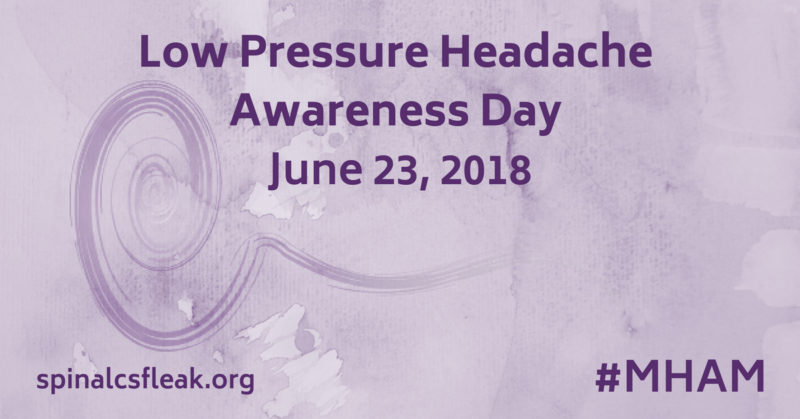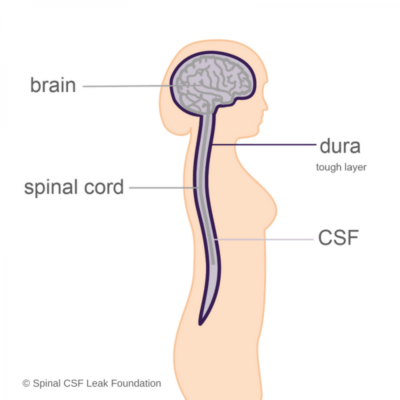June is National Migraine and Headache Awareness Month #MHAM
April 28, 2018
June 23, 2018 will focus on Low Pressure Headache

LEARN MORE about #MHAM from CHAMP (Coalition for Headache and Migraine Patients)
What is a “low pressure headache”?
“Low pressure headache” is a common term that neurologists use for intracranial hypotension. It refers to headache that is caused by low cerebrospinal fluid (CSF) pressure in the head due to a loss of CSF volume. This loss of CSF volume is most often due to a CSF leak at the level of the spine (also known as a spinal CSF leak). CSF leaks in the head (cranial CSF leaks) do not cause low pressure headache; this is a very common misconception. This underlying cause of headache and other neurologic symptoms can be treated, and in some cases cured. But this diagnosis is often missed due to low awareness.
What is CSF?
Cerebrospinal fluid (CSF) is the watery fluid that surrounds and bathes the brain and spinal cord in one continuous compartment. It is held in place by a tough layer called the dura mater. “Spinal fluid” and “cerebral fluid” are the same fluid.
What is a spinal CSF leak?
A spinal CSF leak occurs when a hole or tear in the dura mater along the spine allows CSF to leak out. This diagram shows the brain, spinal cord, CSF and the dura mater that holds the fluid in.

What is a low pressure headache like?
The fluid around the brain and spinal cord flows in one continuous compartment held in by the dura mater. By virtue of gravity, the fluid pressure in the head will be equal with the pressure in the spine when we are lying flat, and will always be lower when we are upright. But when the fluid volume is low, the pressure drop going from lying flat to being upright will be a larger drop.
The most common headache pattern is worsening after minutes to hours upright and improved when lying flat which is why it is often described as an “upright headache.”
The head pain often becomes less obviously affected by position change over time. A “second-half-of-the-day” headache is a very common pattern. The head pain is most often at the back of the head, but might be frontal, in both temples, in the face, or involve the whole head.
What are the causes?
Loss of fluid (CSF) volume due to a spinal CSF leak may arise as a result of medical procedures, such as a spinal tap, epidural injection or spine surgery. Trauma such as a stab wound or an accident may cause a spinal CSF leak. BUT, a spinal CSF leak may also arise spontaneously. These “out-of-the-blue” cases are the ones that are often not recognized as being due to a spinal CSF leak. Remember that cranial CSF leaks do not cause low pressure headache.
Learn more about the causes of spinal CSF leak
Is the fluid pressure always low?
Simple measurements of CSF pressure during a lumbar puncture (spinal tap) can be lower than normal but are actually normal in the majority of cases and even high in some cases. A normal pressure measurement cannot be used to rule out the disorder. This is a common misconception. More detailed pressure measurements performed in a few centers are not routinely available.
Are there other symptoms or complications?
Yes, there are many other symptoms and complications due to effects on the brain and spinal cord. Common symptoms include neck pain, nausea, hearing changes, pain between the shoulder blades, sense of imbalance, arm pain, and dizziness. Serious complications are uncommon but do occur.
Learn more about symptoms and complications
How can this be diagnosed?
The pattern of symptoms is very important in suspecting the diagnosis. Simple pressure measurements at the time of a lumbar puncture are often normal. Brain MRI imaging is recommended in all suspected cases, with findings evident in about 80% of cases. Normal imaging is not uncommon and does NOT rule out the disorder. Spinal imaging may be needed to confirm a leak location for targeted treatment but half of cases have normal imaging. It is important to note that the wide range of symptoms and complications similar to other disorders often contributes to misdiagnosis or delayed diagnosis.
Learn more about diagnosis
How is this treated?
Initial treatment may be conservative if the symptoms are not severe. This might include bedrest, oral and IV fluids, oral and IV caffeine. Some cases resolve without any further treatment. For those that require treatment, epidural patching with the patient’s own blood is the mainstay of treatment. This is a spinal injection into the space within the spinal canal but just outside the dura mater. This can be repeated a number of times. Epidural patching with fibrin glue can be directed at specific leak locations. A percentage of patients will require surgical repair by a spinal neurosurgeon.
What is the prognosis for patients that receive this diagnosis?
Overall, the prognosis is good for the majority of patients with appropriate diagnostic testing and treatments. Some patients continue to have persistent symptoms despite several procedures, due in part to the limitations of currently available imaging.
What should I do if I think my headache could be a “low pressure” or “spinal CSF leak” headache?
Talk with your healthcare providers about the possibility. You may need a referral to see a neurologist, headache neurologist, other headache specialist, neurosurgeon, neuroradiologist, or anesthesiologist who has more familiarity with this disorder.
Further info:
Patient stories and other videos
Watch our video patient stories and check out our other educational videos.
Our annual symposium
Learn more about our annual Cedars-Sinai Intracranial Hypotension Symposium in partnership with Spinal CSF Leak Foundation features.
Awareness events
Leakweek is an annual spinal cerebrospinal fluid leak awareness week hosted by Spinal CSF Leak Foundation. Duradash® is a virtual activity challenge that usually takes place in the springtime, often in the leadup to leakweek.




